
Friday, June 28, 2013
Synchrotron
The Canadian Light Source is a national research center located at the University of Saskatchewan. They pursue research using a synchrotron. This is a type of cyclic particle accelerator that accelerates electrons to speeds approaching the speed of light. This leads to extremely powerful beams of light that can be tuned to any desired wavelength. CLS scientist built this end station. As I understand from their description, the beam of light coming off the synchrotron enters the optics hutch, the white bit that takes up about 2/3 of the right portion of this model, via that gray nozzle on the right side. Inside the optics hutch, the beam is focused and tuned to the desired wavelength. The resulting narrow beam leaves the optics hutch and hits the experimental hutch, the white bit on the left hand side of this photo. There scientists study how the light energy affects or interacts with some sample they are interested in.


Friday, June 14, 2013
Mars Science Laboratory Curiosity Rover will be an official set
Today LEGO announced that they approved Stephen Pakbaz's Mars Science Laboratory Curiosity Rover as the next Cuusoo set. Cuusoo is a crowd-source site where LEGO builders can propose set ideas, and if they get 10,000 votes, LEGO will consider releasing them as official sets. I love the fact that they're choosing this, and not the latest proposal inspired by TV/movies/video games. This set is very much in the spirit of the Shinkai 6500 and Hayabusa sets, the first two Cuusoo sets, and also ongoing collaborations between LEGO and NASA. Stephen is a JPL engineer, and he's said that he was inspired by previous LEGO NASA sets. Here's to the future generations that will be inspired by this new set to look to the stars (er, planets)! Congratulations, Stephen! Via the Brothers-Brick.


DNA patent ruling
Here's some DNA. I'm not sure who built this, as this was at a public display and turns up in several people's photo streams. Anyway, you might ask why post this today, as I just posted a model of DNA in my last post. Well, this gives me a chance to write about the ruling from the US Supreme Court in the case of Association for Molecular Pathology v. Myriad Genetics, Inc. As I understand it, Myriad held a series of patents, and some were upheld while others were struck down. To understand this case, we have to start with a description of transcription/translation. DNA resides in the nucleus, and protein synthesis takes place at the ribosome outside the nucleus. In order to get the information from the DNA to the ribosome, a copy is made, the complementary strand of RNA. So, for instance, let's say there is a DNA strand that goes GCGCAAGC. The complementary strand of messenger RNA is CGCGTTCG (C's match with G's, G's match with C's, T's match with A's). But, let's go a little further. About 98% of the human genome is not used for making proteins. When this non-coding DNA (sometimes called 'junk DNA', but it does actually have important regulatory function) comes in the middle of a DNA sequence, it is called an intron. So the unwanted parts are removed. So, for instance, our CGCGTTCG strand could be trimmed down to just CGCGCG, and this mature mRNA would code for the protein Arg-Ala (groups of three RNA bases are called 'codons', and code for different amino acids). Okay, back to Myriad Genetics. They found that a mutation in the code for a particular protein is associated with certain kinds of breast cancer. So, in our example the healthy cell has DNA GCGCAAGC, which leads to mRNA CGCGTTCG, which is modified to mature mRNA CGCGCG, which codes for protein Arg-Ala. Let's say the potentially cancerous cell has DNA CCGCAAGC, which leads to mRNA GGCGTTCG, which is modified to mature mRNA GGCGCG, and this would code for protein Gly-Ala, and let's say this protein is associated with cancer. Myriad came up with a test for the presence of this mutation. Their test involved creating a shortened form of DNA with the introns removed, called complementary DNA. In our example this would be CCGCGC (note it is missing the AA from above). They take mRNA from the patient, and see if it binds to this complementary DNA. If it does, it indicates the presence of a mutation that could lead to cancer. They then took out patents on the process of comparing the mRNA to their complementary DNA, the sequence in the complementary DNA (CCGCGC), and also the sequence in the initial DNA (CGCGCAAGC). What the Supreme Court ruled yesterday is that the third type of patent is invalid, as the sequence of DNA in the living cell (either healthy or cancerous), is a 'product of nature'. That is, Myriad did not invent it, so they cannot patent it. OTOH, the complementary DNA is not naturally existing, and so therefor may be patented. It is also valid to patent a novel method involving this complementary DNA. So it was a mixed ruling, but IMO a correct one. The human genome is still there available for anyone to do research without fear of being sued for patent infringement, but there is still incentive for companies to produce new types of tests that they can protect with patents.
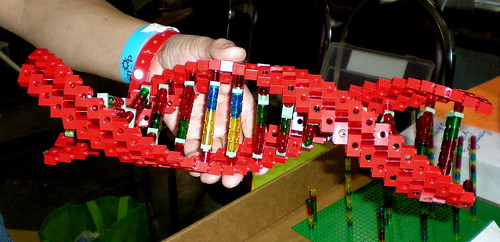

Monday, June 10, 2013
DNA
There are a lot of LEGO renditions of DNA out there, indeed I chose one for the banner of this blog, but most don't really have an accurate structure. This one by SICP_DNA, though, is very good about keeping to the actual structure of DNA. In DNA, the strands on either side are pointing in opposite directions, and the white and gray backbones have the studs pointing in different directions here. Since the backbone sugars are asymmetric, the 'grooves' are different sizes. Another aspect of DNA is that two of the bases, the purines A and G, are larger than the other two, the pyrimidines T and C. The connections here are such that it only works out when A lines up with T or G lines up with C. They also got the sizes right here, so that one complete twist takes ten steps, and the width to height ratio is approximately correct.


Here you see a comparison between the 'real' structure of DNA, and a simplified depiction. BTW, the LEGO version below is from Nathan Sawaya's Building Bricks of Life. I certainly mean no disrespect, as it is a great model. But as Nathan has said elsewhere he's an artist, not a scientist, and he writes that he decided to go with this more artistic approach (as a commissioned piece for the Archon Genomics X Prize) rather than try to do a more accurate version. Someday I'd like to see him go back and do an accurate depiction of DNA. He's a great sculptor and I'm sure it would be quite cool.
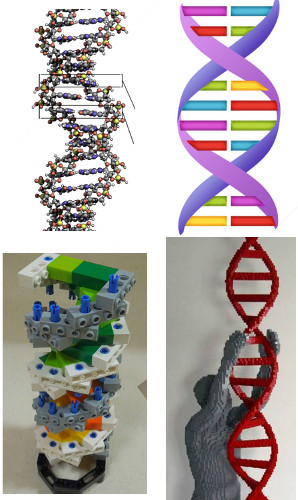
BTW, since I've posted two Cuusoo projects in a row, I wanted to say a little about that. I was corresponding with another LEGO blogger the other day about these, and I agree with him that a great number of the things posted there are not actually viable LEGO sets, including this one (sorry, SICP_DNA). So if I blog something, it is not necessarily true that I am supporting it as a Cuusoo project. I just see Cuusoo as another place where LEGO builders post their creations, along with other photo sharing sites.


Here you see a comparison between the 'real' structure of DNA, and a simplified depiction. BTW, the LEGO version below is from Nathan Sawaya's Building Bricks of Life. I certainly mean no disrespect, as it is a great model. But as Nathan has said elsewhere he's an artist, not a scientist, and he writes that he decided to go with this more artistic approach (as a commissioned piece for the Archon Genomics X Prize) rather than try to do a more accurate version. Someday I'd like to see him go back and do an accurate depiction of DNA. He's a great sculptor and I'm sure it would be quite cool.

BTW, since I've posted two Cuusoo projects in a row, I wanted to say a little about that. I was corresponding with another LEGO blogger the other day about these, and I agree with him that a great number of the things posted there are not actually viable LEGO sets, including this one (sorry, SICP_DNA). So if I blog something, it is not necessarily true that I am supporting it as a Cuusoo project. I just see Cuusoo as another place where LEGO builders post their creations, along with other photo sharing sites.
Friday, June 7, 2013
Female figs Cuusoo project
Cuusoo is a LEGO website for crowdsourcing set ideas. You propose a set, and if it gets 10,000 votes, LEGO promises to take a serious look at producing the set. Most of the sets that have made it to 10,000 have been attached to some movie/TV show/video game, and fans of that movie/show/game help push it over the top. That said, there have been two science driven sets already produced, the Shinkai submarine and the Hayabusa space probe, in the original Japan-only version of Cuusoo, and the Mars Curiosity Rover is being considered in the most recent round of creations that have reached 10,000. Now it seems that socio-political forces are pushing another to the top. Alatarial designed Female Minifigs to help correct the gender imbalance in Legoland, putting women in small scenes depicting different occupations. The cool thing, and the reason why I'm posting this here on SciBricks, is that many of those occupations are as scientists, probably because Alatarial is herself a geochemist: paleontologist, astronaut, astronomer, chemist, (falconer), geologist, and engineer (plus six others in non-science roles not shown here). I assume that this was recently posted on some social media site, or featured in some news source, because the project jumped from 2500 votes to 7500 in just three days.
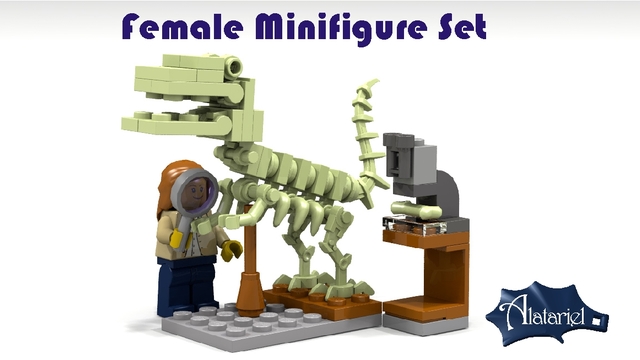

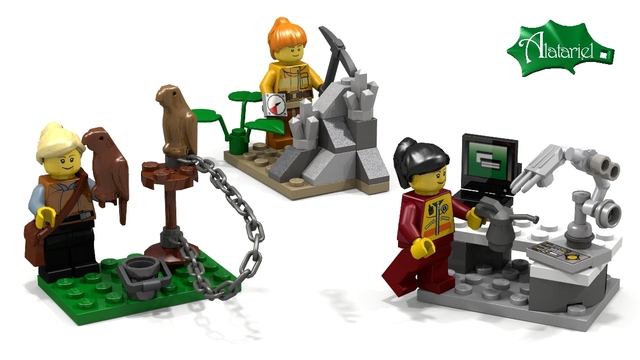



Thursday, June 6, 2013
NASA's Missions: Imagine and Build
I noted this a couple of weeks ago, but did not have details at that point. LEGO has teamed with NASA for a contest, NASA's Missions: Imagine and Build. Two categories (subdivided into age ranges) challenge you to either build a MOC based on a currently planned NASA mission, or to build the aircraft of tomorrow. The second category is supposed to be accompanied by a technical paper, so they're looking for someone with some knowledge, not just clicking some bricks together and swooshing the creation around your room. We're all looking at you, Apojove (jk, I know there are a ton of AFOLs out there with real science and engineering expertise).


Wednesday, June 5, 2013
ATV-4 "Albert Einstein"
Brainbikerider built the ATV-4 "Albert Einstein". I'll just be lazy and copy his whole description:
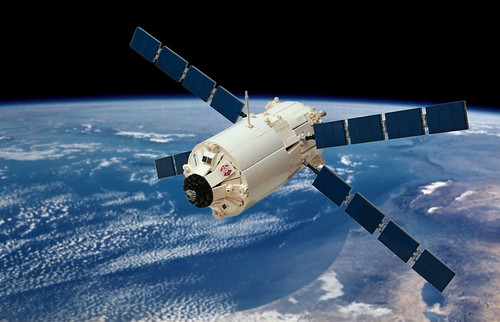
The ATV (Automated Transfer Vehicle) is ESA’s unmannded resupply spacecraft for the ISS. The mission of this “real world X-Wing” is not only to transport cargo and propellant, but also to reboost the Space Station into a higher orbit. Currently, it’s the most powerful resupply spacecraft with a cargo capacity of more than 6.5 tonnes. The fourth ATV, named after the famous scientist Albert Einstein, will be launched today on an Ariane 5 rocket at ESA’s spaceport in Kourou. You can read more about the ATV here.

Saturday, June 1, 2013
Petri dish
As anyone who uses Google knows, today they recognized Julius Richard Petri's 161st birthday. A Petri dish, aka a cell culture dish, is a shallow round dish with a raised edge, often used by microbiologists to grow bacteria or other microorganisms (here in LEGO by MorsLEGO). Usually the dish is partially filled with a warm liquid mixture of agar and nutrients. After it cools the agar becomes a semi-solid gelatin that is an appropriate surface for growing the bacteria, which can be studies as they grow.
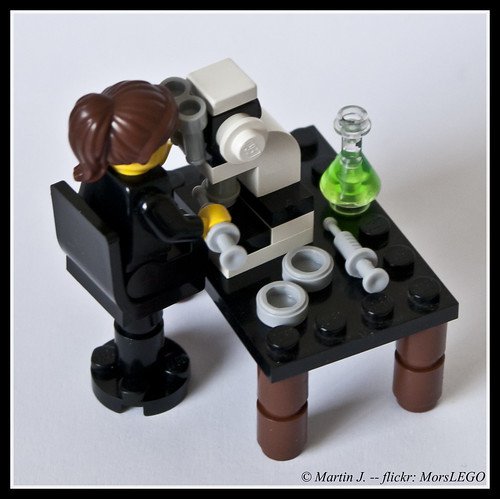
In a fun twist, artist Darlene Charneco made Podland Petri.
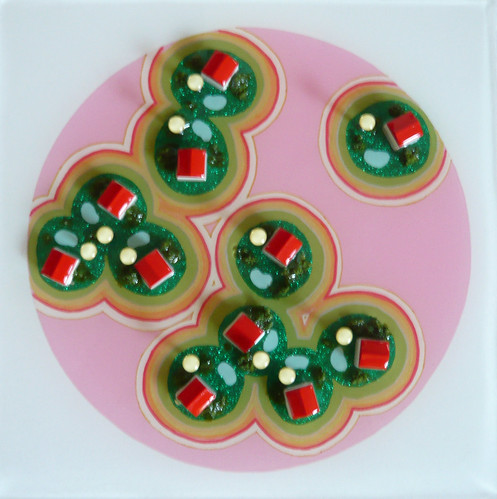

In a fun twist, artist Darlene Charneco made Podland Petri.

Subscribe to:
Comments (Atom)